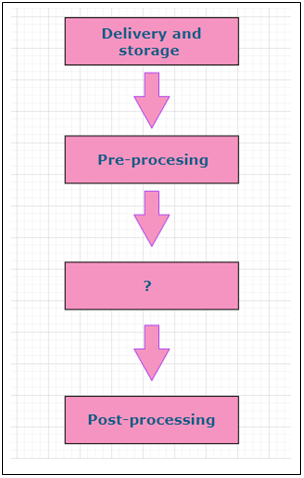This set of Environmental Biotechnology Multiple Choice Questions & Answers (MCQs) focuses on “Anaerobic Treatment of Solid Wastes and Biogas Generation”.
1. Which of the following condition is not suited for anaerobic treatment of solid wastes?
a) Controlled temperature
b) Controlled moisture
c) Closed vessel
d) Open vessel
View Answer
Explanation: The anaerobic digestion of solid wastes is usually carried out under anaerobic conditions where the temperature is controlled and mainly high moisture control. This is usually carried out in a closed vessel to maintain temperature and particular conditions inside the vessel. Therefore, this digestion cannot be carried out in an open vessel.
2. Which of the following type of waste is best suited for anaerobic treatment of solid wastes?
a) Readily biodegradable compounds
b) Less moisture content
c) Less degradable
d) High temperature content
View Answer
Explanation: Readily biodegradable compounds and wastes with high moisture content are best suited for anaerobic treatment as the anaerobic digestion of wastes is carried out under anaerobic conditions where the temperature and moisture is controlled. So, moisture content is high and is highly degradable and temperature need not be very high.
3. The technological potential of the biological wastes has been fully exhausted.
a) True
b) False
View Answer
Explanation: The technological potential of the degradation of biological wastes by fermentation has not been fully exhausted yet as a huge amount of energy and scientific techniques have been implemented in this process with wider developmental and optimization. This makes the process quite new and young.
4. Which of the following is the most important product of anaerobic digestion?
a) Biogas
b) Acetic acid
c) Amino acid
d) Calcium
View Answer
Explanation: Biogas is the most important product of anaerobic digestion where organic matter is converted into simpler components by fermentation process. The entire process is divided into three steps i.e. hydrolysis, acidification and methane formation. This last steps generates biogas which is one of the most important product. In the acidification process acetic acid is produces and Amino acid is also produced during the process but in much earlier step and is not the most important product of anaerobic digestion. Calcium is not produced in any of the steps.
5. Which of the following has less organic matter load?
a) Marshlands
b) Marine sediments
c) Landfill sites
d) Fresh water
View Answer
Explanation: Fresh water has the lowest organic matter load, and Marshlands, Marine sediments, Landfill sites, rice fields are the areas with the highest organic matter load. So, organic matter loading is an important parameter of anaerobic digestion. Anaerobic digestion is carried out by various bacteria involved in three major steps of anaerobic digestion.
6. Which of the following is not an important step of anaerobic digestion?
a) Hydrolysis
b) Acidification
c) Methane formation
d) De-acidification
View Answer
Explanation: De-acidification is not carried out in anaerobic digestion. Anaerobic digestion is carried out by various bacteria involved in three major steps of anaerobic digestion. The entire process is divided into three steps that is hydrolysis, acidification and methane formation or methanogenesis. Hydrolysis converts organic matter; Acidification forms acetic acid and methanogenesis leads to methane.
7. Which of the following causes decomposition of water insoluble biopolymers?
a) Hydrolysis
b) Acidification
c) Esterification
d) Methanogenesis
View Answer
Explanation: Hydrolysis using various extracellular enzymes can breakdown water insoluble biopolymers like monosaccharides, glycerin, fatty acid etc. Acidification can begin with the product of previous reaction and hence, is depended on Hydrolysis, methanogenesis leads to methane formation. And Esterification combines organic acid with alcohol.
8. Continuous fermentation necessitates continuous loading and discharge.
a) True
b) False
View Answer
Explanation: High amount of substrate or the organic matter is fed into the fermenter for Continuous fermentation. Fully mixed and plug flow system is available in the fermenters which helps in the process. The waste should be able to flow and uniform, this enables continuous biogas formation and stable operation of continuous fermentation. Therefore, continuous loading and discharge of waste is a necessity.
9. What is the third step for anaerobic processing of organic wastes?

a) Homogenization
b) Active feeding
c) Drying under adequate light
d) Anaerobic fermentation
View Answer
Explanation: Anaerobic fermentation is the third step for anaerobic processing of organic wastes where the wastes are shredded into the fermenter for anaerobic digestion which is degraded in the process. Homogenization is the break it down of wastes into simpler molecules, whereas, active feeding or Drying under adequate light in not carried out as it’s a closed vessel in anaerobic processing.
10. What is dry fermentation process?
a) Water content between 55%-75%
b) Water content between 85%-95%
c) Water content between 80%-85%
d) Water content between 0%-15%
View Answer
Explanation: Water content between 55%-75% is the most suitable for dry fermentation process with different moisture content for fermentation in the fermenters under anaerobic processing, whereas, Water content between 0%-15% is very dry and the solid wastes cannot be processed by dry fermentation process of anaerobic digestion, water content between 85%-95% and water content between 80%-85% is usually categorized as wet fermentation.
Sanfoundry Global Education & Learning Series – Environmental Biotechnology.
To practice all areas of Environmental Biotechnology, here is complete set of 1000+ Multiple Choice Questions and Answers.
If you find a mistake in question / option / answer, kindly take a screenshot and email to [email protected]
- Practice Biotechnology MCQs
- Check Biotechnology Books
- Check Environmental Biotechnology Books
- Apply for Biotechnology Internship
